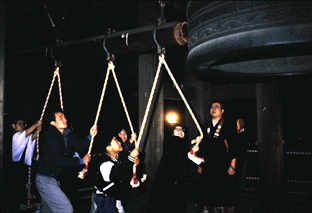ANNUAL CALENDAR December |
|
Ushering in the New Year
|
 The final day of the year, December 31, is called omisoka in Japan. In order to usher in the new year feeling fresh, families have to finish up cleaning their house and making preparations for the New Year holidays by omisoka. Kids are in the middle of winter break, and they usually help out with the chores.
The final day of the year, December 31, is called omisoka in Japan. In order to usher in the new year feeling fresh, families have to finish up cleaning their house and making preparations for the New Year holidays by omisoka. Kids are in the middle of winter break, and they usually help out with the chores.
A lot of college students and working people who moved to big cities to attend school or take on a job return to their hometowns to spend New Year's with their families, friends, and relatives. On New Year's Eve, many families gather around the TV set to watch special omisoka programs and eat toshi-koshi ("year-crossing") buckwheat noodles in the hope that one's life will be stretched out as long as these noodles. New Year's Eve is the one day of the year when kids don't get scolded for staying up late. As midnight approaches, Buddhist temples around the country begin ringing out the old year (literally!), sounding the temple bell 108 times. This practice is based on a belief that humans have 108 earthly passions they have to overcome in order to attain enlightenment, and each ring is thought to drive away one such passion. People wait until the reverberations have completely died down from each bell toll before making the next strike, and so it takes about an hour to complete the 108 strokes. The tolling of the bell at some of the nation's most famous temples is broadcast live on television and radio. Many people welcome the new year by listening to the calming sounds of these bells. The breaking of dawn the next morning is much more than just the beginning of a new day. Oshogatsu (the first three days of the year) is Japan's biggest holiday, and people flock to temples and shrines to pray for a healthy and prosperous year--regardless of their religious affiliation. This visit is called hatsu-mode, which used to mean going to a Shinto shrine before dawn and paying respects to one's guardian deities as dawn broke. Today, though, a visit made by January 7 is considered part of hatsu-mode. Trains and buses that normally stop running late at night operate on a 24-hour basis between omisoka and New Year's Day.
Photo: Ringing in the new year. (Kyodo) |
APR | MAY | JUN | JUL | AUG | SEP | OCT | NOV | DEC | JAN | FEB | MAR |
 |